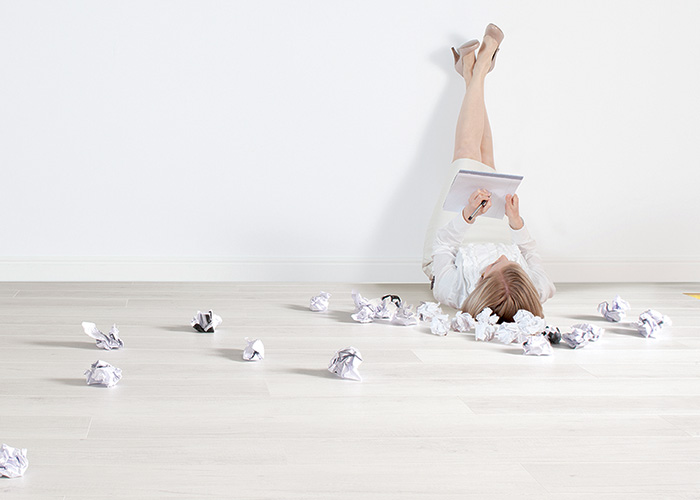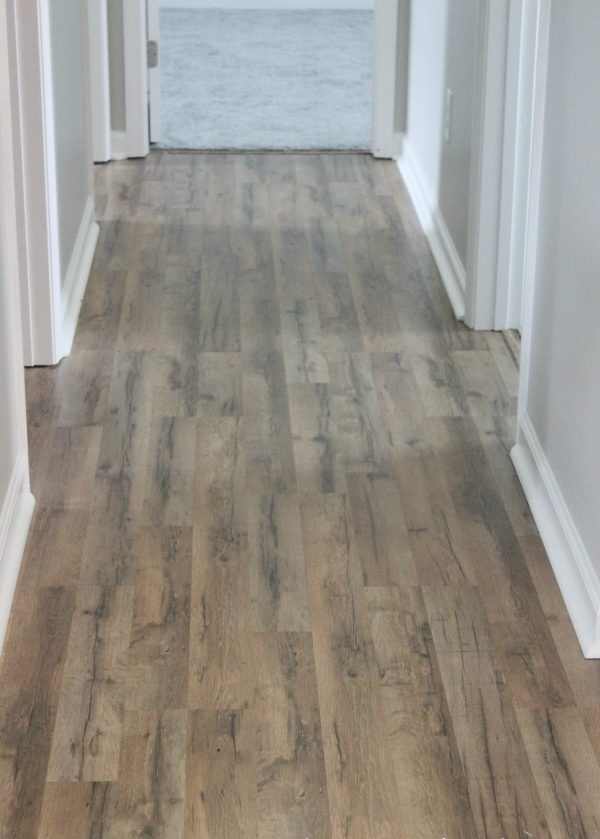TIPS TO CHOOSE THE BEST LAMINATE FLOOR AND MAKE IT LAST FOR LONG
The superficial layer of a laminate floor will protect it from humidity, impacts and abrasions. However, by following a few rules, it’s possible to make it last even longer.
Limit the excess of humidity. To clean a laminate floor, there’s no need of bucket, brush and polisher: they won’t be effective and may even damage it. Using a damp cloth is much better.
Use non-aggressive detergents. Only use detergents recommended by the manufacturer, or those specifically created for laminate (they’re not necessarily the same as those for tiles or vinyl). Polish and bleach should also be avoided. In case of persistent stains on Skema Living floors, a thinner can also be used.s
Clean immediately, clean often. Since a frequent and aggressive washing can damage laminate over time, the alternative is prevention. Use a vacuum cleaner or a broom often, and clean immediately any residual soil, pebbles, or liquid spills. A doormat can be useful to keep out dirt and humidity.

Tips for Choosing Laminate Flooring
Budget:
Ugh! I really don’t like that word, do you? ? But, like any DIY or renovation project, it’s one of the first considerations you must keep in mind. You wouldn’t think there would be a major difference in total pricing between flooring that cost $1.89/sf and $3.39/sf. I mean, there’s only a $1.50 difference right? Until you multiply that by 1000+ sf. Like any project, you need to break down the costs of the total renovation and decide what percentage you can dedicate to each category. To a new homeowner, it seems logical that you would spend as little per square footage as possible. I mean, savings is savings. Here is where I will a huge and loud NO! Savings is always a good thing, but not when it comes to the item that will receive the most wear and tear in your home. Don’t be fooled into thinking that flooring is flooring is flooring. Especially when it comes to laminate. I would suggest spending a little more and getting a better product that is within your budget’s means.
Durability and Use:
Think of all the foot traffic your poor floors will see during it’s lifetime. Muddy shoes, dogs and cat paws, bouncing balls and legos. Okay, maybe that’s just in MY home. ? We learned the learned way many years ago that choosing the right type of flooring for the home was key to how long said flooring would last. The good thing about much of the newer types of laminate flooring is it is virtually resistant to most scratches and impacts.
Looks and Style:
Just like with other types of flooring, the variety of laminate flooring on the market now is almost endless. That is why I love to change up the design when choosing a flooring for a new flip project. Besides the paint choices, the flooring is one of the elements that literally set the design tone of the entire home. If you want to go Farmhouse, there are endless choices for old barn wood style floors. Coastal? I love the driftwood look. Contemporary, classic, rustic? There is a flooring for you which will meet your budget demands.
Installation:
Another thing I love about laminate flooring is the ease of installation. It is a doable DIY project that almost any homeowner can tackle. I was petrified the first time we installed laminate flooring ourselves. We had been hiring it done in the past, but because of a tight budget in one of our renovations, my son and I decided to tackle the job to save money. We asked lots of questions at the local home store, we watched youtube videos, and we asked more questions. And we did it! And darn it – it looked amazing! ? The glueless options of laminate flooring totally changed the process. When the interlocking systems were first introduced, I will be the first one to admit they were not very good. I will say THIS is where the budget plays a big role in the type of flooring I choose. I will not buy a laminate flooring less than 8mm thick, and prefer to have a flooring at least 10mm thick. The better quality of flooring will have a better and more durable interlocking system, which is key to installation. Laminate flooring is a “floating” system which can be installed over virtually any type of existing subfloor.
Placement:
I try to avoid placing laminate flooring is “wet areas,” meaning bathrooms and laundry rooms. Until now. Shaw Floors has just introduced a brand new type of flooring that is completely water resistant and it is absolutely stunning. I learned about it at a recent Blog Conference and was absolutely “floored.” (see what I did there?) ? This new technologically-advanced flooring has now revolutionized laminate so that it can be used anywhere in your home, without having to resort to different types of flooring in the different areas of your home. (this will also save you time and money on those transitions I mentioned above.)

How to Choose Laminate Flooring: A Buyer’s Guide
Don’t Forget LV Flooring!
Laminate floors aren’t the only option for durability and ease of installation. Next time you’re at the home center, take a gander at luxury vinyl (LV) flooring. There’s luxury vinyl tile (LVT), which looks like ceramic tile, and luxury vinyl plank (LVP), which mimics wood (shown here). Both types are extremely resilient, about the easiest flooring in the world to install and completely waterproof. Since luxury vinyl is so pliable, it’s a great choice over uneven subfloors.
Don’t Forget the Underlayment
All laminate flooring needs foam underlayment. Don’t skip it. Underlayment prevents the floor from clicking on the subfloor as you walk across it and makes it feel a bit softer. It also makes the planks easier to install because it evens out small inconsistencies in the subfloor. Some underlayment has self-adhesive tape to join one row to the next. Others call for separate tape. Be careful to use whatever is required. Go ahead and buy the special laminate and wood flooring installation tool as well. You’ll need it to pull together flooring ends where each row abuts a wall.
Choose a Finish Based on Lifestyle, Not Just Looks
If you lead a quiet life, choose whatever flooring style appeals to you. But if you have one of those crazy households with kids, pets and lots of visitors, be a bit more careful. Flooring with a varied grain pattern, a low-gloss finish or distressed or hand-scraped patina will look much better, much cleaner, much longer than flooring with a glossy, monolithic grain pattern.
Avoid Wide Planks Unless the Substrate is Perfect
The directions will tell you the amount of slab or subfloor unevenness tolerated by the brand and type of flooring you buy. Over an uneven floor, wider planks will be harder to snap together, end joints won’t stay flush with one another and there will be more gaps beneath the planks that you’ll feel when you walk across the floor. So if your concrete or wood subfloor is quite uneven, you’re better off selecting a narrower plank style, and being thorough when you apply the floor leveling compound.

How to choose the best laminate flooring
HOW MUCH DOES LAMINATE FLOORING COST?
Laminate flooring can cost as little as £6m² for the most basic 6mm thick planks from an online flooring dealer, or a high-street DIY warehouse. If you’re going for a better quality option, usually 8mm to 12mm, look at paying around £20m².
CAN LAMINATE FLOORING BE LAID OVER UNDERFLOOR HEATING?
Most laminates are appropriate for use with underfloor heating, but make sure this is specified by the manufacturer to avoid damage or inefficiency before you buy. It’s also important to ensure you have the right underlay.
WHERE CAN YOU LAY LAMINATE FLOORING?
There is a laminate flooring on the market for every room, whether it’s a high traffic area such as the kitchen, or somewhere that needs waterproofing, for example the bathroom.
HOW DURABLE IS LAMINATE FLOORING?
An AC rating is an important factor to consider when you’re deciding which laminate to use in a room and is used to tell how durable a product is.
HOW TO LAY LAMINATE FLOORING
It is possible to DIY-fit laminate flooring yourself, as manufacturers have developed simple, stress-free interlocking systems so that laminate flooring is quick and convenient to lay. If you’re a keen DIYer who’s up to the challenge, use our guide to laying laminate floor as a basis.
The Complete Buyer’s Guide To Choosing Laminate Flooring
What is laminate flooring?
Laminate flooring is a type of floor covering that is made from several layers of material to form a firm and durable type of flooring. It usually has at least 4 layers.
A backer layer – this layer provides the stability and support for the flooring and is the base of the laminate flooring
What are the different types of laminate flooring?
Laminate flooring comes in a variety of different types.
There are 2 main styles of laminate flooring: plastic laminate and engineered wood laminate. Read more about the differences between laminate and engineered wood.
It’s no surprise that the engineered wood laminate can be more expensive than its plastic counterpart. However with careful care, it can end up lasting much longer than the plastic laminate.
What are the different finishes for laminate flooring?
With hundreds, if not thousands of different finishes on the market, choosing the look of your laminate can be a daunting task.
First consider what kind of look you want in your home. The most common styles are wood effect, tile effect and stone effect.
Is laminate flooring waterproof?
There are some laminate flooring planks on the market which are water resistant or waterproof.
They need to be installed very carefully and include 100% silicon sealant and a foam backer road around the entire perimeter of the room.
Does laminate flooring need underlay?
Generally yes. Underlay serves a few purposes.
It adds an extra layer of moisture protection, so if you ever have any leaks from underneath your flooring, it is less likely to seep through to your laminate flooring.